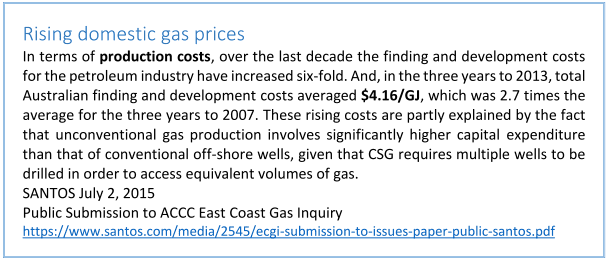Approaches for increasing the supply of natural gas were on the agenda, but renewable energy production of natural gas didn't get a mention. The absence of Bioenergy Australia which is holding a Bioenergy Business Breakfast in Adelaide next week left the struggling oil and gas industry bereft of a host of ideas to address the intractable problem of rising costs of extracting natural gas. The problem it faces is that there aren't any more low-cost natural gas reserves to exploit.
New methods for producing natural gas from renewable energy are being developed and refined, continually lowering costs and improving efficiency.
At the same time:
- The cost of extracting coal seam gas is constantly increasing.
- The domestic price of natural is continuing to rise.

The wholesale price of natural gas in Australia has risen steeply
There are 3 underlying processes for making renewable natural gas no matter how the various technologies achieve them:
- Carbon dioxide can be converted into carbon-containing compounds and oxygen by algae and other plants using sunlight to drive photosynthesis.
- Carbon dioxide can also be converted into natural gas and water using hydrogen produced from electrolysis of water using electricity from renewable energy generation. Oxygen is produced as a by-product as in the first process.
- Any carbon-containing compounds including those produced by algae and plants in the first process described above along with farm waste and municipal waste, can be converted into a mixture of methane and carbon dioxide. About half the carbon in the input feed stock is converted into methane, and the other half into carbon dioxide. After the carbon dioxide produced as a by-product is separated, it can be converted into methane by recycling it into either of the first two processes. No "carbon capture and storage" required, avoiding a susbstantial cost of using natural gas from fossil fuel reserves.
- Long established technologies use methane-producing bacteria that create methane and carbon dioxide in anaerobic fermentation ponds or tanks.
- More recently plants have become available that use supercritical water as a gasification medium to create methane and carbon dioxide. These complete the gasification process more quickly and so don't need large tanks where methane-producing bacteria gradually transform the feed stock. This newer technology is especially well-suited for wet feed stock as there is no need to dry it.
Making renewable natural gas from wet biomass, no #CSG -— Askgerbil Now (@Askgerbil) 3 April 2017
1/ https://t.co/cbAnvLLgQi
2/ https://t.co/bA1a1XcUY1
3/ https://t.co/Xyy79DHFEoWaste and cheap coal in hot water. The produced gas is rich in hydrogen. Reforming in supercritical water. #energy https://t.co/Og47qUDG8Y— Askgerbil Now (@Askgerbil) June 17, 2017
These more recent technologies can also efficiently convert low-grade coal with high moisture content into natural gas. Existing coal-fired power could use this option to improve efficiency and lower emissions until it is feasible to decommission them.
Researchers at ENN Group, China and Carleton University, Canada recently investigated supercritical water lignite gasification technology. See "Coal-based Clean Energy Production", Advances in Energy Engineering (AEE) Volume 1 Issue 4, October 2013.
 |
| Supercritical Water gasification of wet biomass and low-grade coal |
More recently the Lappeenranta University of Technology, Finland, completed an assessment of the option of Australia becoming a major exporter of renewable energy to Asia - making use of the Queensland LNG export facilities - to ship natural gas made with renewable energy. See "Can Australia Power the Energy-Hungry Asia with Renewable Energy?"


0 comments:
Post a Comment